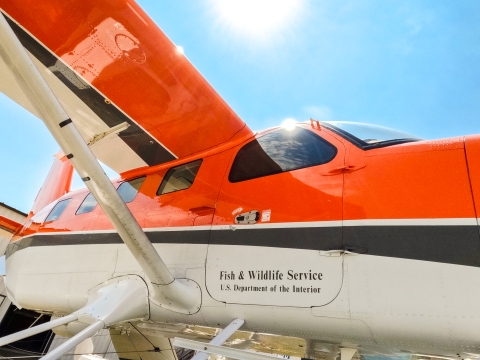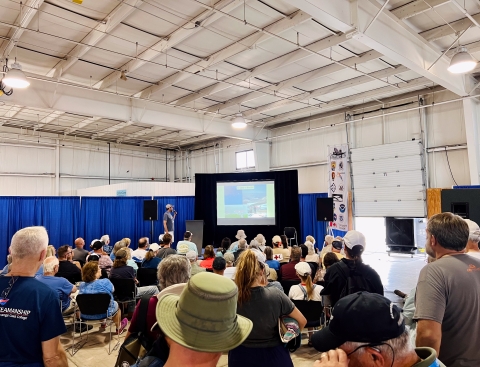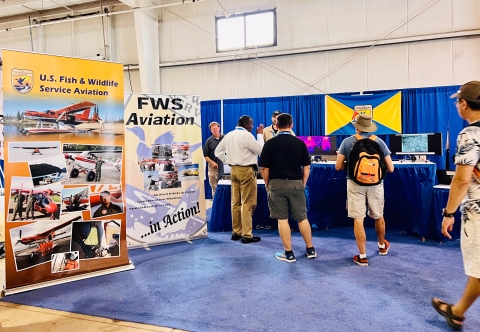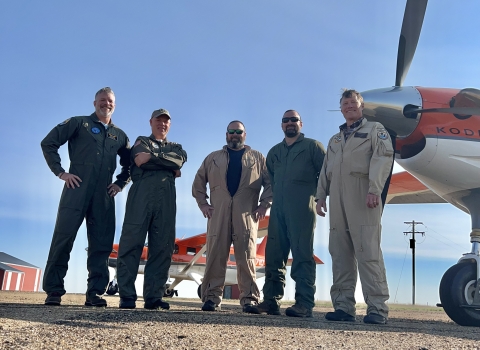When you think of the EAA AirVenture fly-in event in Oshkosh, Wisconsin, you likely envision pilots performing aerobatics overhead and rows of vintage and homebuilt aircraft on display. And you’d be right! But this year, the U.S. Fish and Wildlife Service's (the Service) Branch of Aviation Management brought even more to this internationally renowned convention by showcasing the captivating field of aviation and conservation. In the hustle and bustle of the world’s largest aviation celebration, the Service’s booth stood out in the International Federal Pavilion by educating and inspiring the public about the essential, and often surprising, role of aviation in our conservation mission.
From wildlife surveys and habitat monitoring to law enforcement surveillance and fire management, the Service's Aviation Program has been expanding to cover a broad spectrum of conservation work across the continent through the Migratory Birds Program, National Wildlife Refuges (Refuges), and Office of Law Enforcement (OLE). Representing over half the Department of Interior aircraft, the Service’s diverse fleet now includes 49 airplanes, a helicopter, 135 Uncrewed Aircraft Systems (UAS), and supports 45 pilots and 82 UAS remote pilots. The fleet's aircraft are uniquely designed for adaptability, including amphibious, ski-equipped, off-airport, and aerial remote sensing capabilities that expand the potential for aviation operations.
This year, the EAA AirVenture event was similarly expansive and diverse as it welcomed the highest number of visitors in its 70 years at 677,000 people from 94 countries! Over the course of the event, representatives of the Service’s Migratory Bird Program and Refuges illustrated to this seemingly infinite crowd of aviation enthusiasts that Pilot Biologists and Wildlife Law Enforcement Officers are a vital part of the conservation machine.
As some of the most specially trained employees in the agency, Pilot Biologists help monitor migratory birds and other wildlife populations to conserve and manage habitats, conduct status assessments, and establish harvest regulations. Through aerial surveys like the historic Waterfowl Breeding Population and Habitat Survey, the longest running wildlife survey in the world, these biologists have been the “eyes-in-the-skies," collecting integral data for the Service since 1947. Outside the hangar, a tangible symbol of this awaited visitors: one of the iconic Daher Kodiak survey planes. Migratory Bird Pilot Biologist Garrett Wilkerson was there answering questions, telling stories from the field and inspiring the next generation of pilots.
Meanwhile, a monitor displaying infrared video of anyone who walked by the UAS on the Service’s booth captured visitors' attention and drew them in to learn more about what the Service was there to share. What a great way to get people's attention! UAS Program Manager Scott Bishaw used this opportunity to explain how specialized infrared technology and heat tracking functions are valuable tools for aerial wildfire prevention and law enforcement. He spoke to the significant benefits emerging UAS technologies offer, not only in efficiency but also in minimizing disturbance and offering new possibilities in natural resource management, law enforcement, disaster response, fire management, and public affairs. Special Agent Pilot Kurt Rees and Federal Wildlife Officer Pilot Cody Smith elaborated with how their unique role uses specialized aviation technologies for providing critical aerial support, patrolling remote areas of Refuges, conducting search and rescue missions, and in enforcing federal wildlife laws such as the Lacey Act, Marine Mammal Protection Act, Endangered Special Act, and Migratory Bird Treaty Act.
Service presentations drew big crowds at the International Federal Pavilion. Kara Hilwig, Togiak Refuge Pilot Biologist unpacked the realities of being a Pilot Biologist in remote Alaska and Brad Scotton, Supervisory Pilot Biologist at Koyukuk/Nowitna Refuge detailed the responsibilities of such a unique position. Garrett Wilkerson described the Migratory Bird Program's annual waterfowl surveys flown from Canada to Mexico in N708 and how it informs waterfowl management decisions across North America. Service pilots tending the booth shared with passersby the exciting opportunities that future pilots and emerging aerial technologies will bring to conservation.
The Service's presence at EAA AirVenture positively illustrated the critical role of aviation in supporting our mission of working with others to conserve, protect, and enhance fish, wildlife, and plants and their habitats for generations to come. This opportunity to connect with people from all over the world showed that the love for flight, shared by both the aviation community and birds, can bring people together and contribute to the conservation and protection of our shared natural resources. The sky is the limit!
Department of Interior (DOI) Uncrewed Aircraft Systems (UAS) Policy:
- DOI UAS Policy Information & Guidance
- FWS Aviation Policy Library
- UAS Public Use Policy for FWS Refuges
You can read first-hand field reports from Pilot Biologists at the WBPHS Field Reports Library Collection.
Watch USFWS Pilot Biologists in Action at Selawik National Wildlife Refuge :









